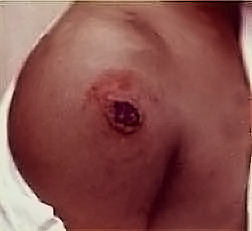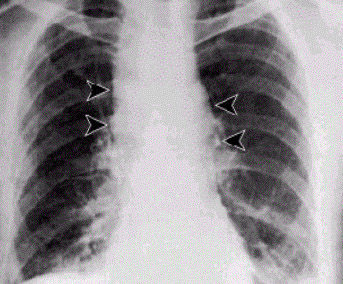Bacillus
CASE 1
• A 19 year old male cow herder has a painless sore on his right shoulder. The sore started as a nodule which broke through the skin to produce an open ulcer with a black necrotic center and raised edges. He has no fever and does not feel ill.

• Based on the appearance, a presumptive diagnosis of cutaneous anthrax was made.
Questions:
1. How do you think that this young man encountered anthrax?
2. Is anthrax a zoonosis?
3. Is this patient infectious for other people? Should he be isolated?
4. How could you confirm the diagnosis? What would you expect to see on a Gram stain from a scraping of the ulcer?
5. What virulence factors allows B. anthracis to cause disease? What causes the damage to the infected host?
6. What virulence factor prevents B. anthracis from being cleared by the infected host?
7. What is most likely to happen to this young man if he is not treated for this condition?
8. Which antibiotics are effective for treating anthrax?
CASE 2
• A 32 year old man was admitted to the hospital with cough and shortness of breath. For the past 2 days, he had been experiencing flu-like symptoms of fever, muscle aches, and malaise. Because of the respiratory symptoms, a chest xray was performed; it showed clear lung fields, but a widened mediastinum (below).

• The patient is a professional drummer and drum-maker. One week before the onset of his symptoms, he received a new shipment of drum skins, covered a new series of drums, and played one of them extensively. This occupational history and the chest xray suggested the possibility of inhalation anthrax to the attending physician. Therefore, the patient was treated with ciprofloxacin and doxycycline. However, before the effects of treatment materialized, he developed sepsis and signs of meningitis. He died on the second day of hospitalization.
Questions:
1. How do you think this patient acquired anthrax?
2. What is the infectious particle that transmits this disease?
3. He is coughing. Should he be isolated from other patients in the hospital to prevent transmission?
4. What is the usual outcome of inhalational anthrax?
5. This disease is rare, but the possibility that it could occur on a massive scale has some health and government officials very concerned. Why?
CASE 3
• A 29 year old man and his 24 year old wife both developed abdominal cramps and profuse diarrhea on the same morning. The previous evening the ate a dinner of fried rice. The rice was left over after dining at a Chinese restaurant 3 days earlier. The leftover rice was taken home and gently reheated for dinner the evening before the symptoms began. Neither the man or his wife suffered any nausea or vomiting; neither had fever.
• After consultation with their physician, they were advised to maintain hydration pending the spontaneous resolution of the diarrhea within 24 hours. The doctor explained that they had most likely acquired Bacillus cereus food poisoning.
Questions:
1. What was in the fried rice that made this couple ill?
2. How could the doctor be sure that they would recover spontaneously?
3. Are there other forms of microbial food poisoning that do not involve productive infection by the pathogen? What are they?